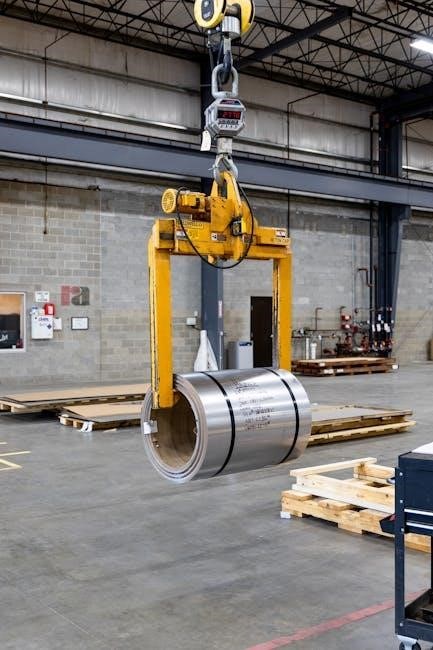lifting operations and lifting equipment regulations 1998 pdf
Lifting Operations and Lifting Equipment Regulations 1998 (LOLER): An Overview
The Lifting Operations and Lifting Equipment Regulations 1998, commonly known as LOLER, represent a cornerstone of safety legislation in Great Britain. They came into force on December 5, 1998, replacing earlier regulations. LOLER places duties on those who own, operate, or control lifting equipment, ensuring safer lifting operations.
Purpose and Scope of LOLER
The primary purpose of the Lifting Operations and Lifting Equipment Regulations 1998 (LOLER) is to reduce the risk of injury associated with lifting equipment and lifting operations. LOLER achieves this by establishing a comprehensive framework of duties and responsibilities for employers, employees, and those who control lifting equipment. These regulations are designed to ensure that all lifting operations are carried out safely and that lifting equipment is fit for purpose, appropriately maintained, and thoroughly examined.
The scope of LOLER is broad, encompassing all lifting equipment used in the workplace, whether for lifting loads or people. This includes a wide range of equipment, such as cranes, forklifts, hoists, and accessories like slings and chains. LOLER applies to all sectors of industry, affecting any business or organization whose employees use lifting equipment, regardless of ownership. The regulations extend to mobile and fixed equipment, covering various operational aspects, from planning and execution to equipment inspection and maintenance. LOLER works alongside the Provision and Use of Work Equipment Regulations (PUWER) to ensure a safe working environment.
Key Requirements of LOLER
LOLER mandates proper planning of lifting operations, use of competent personnel, and thorough examination of lifting equipment. Equipment must be suitable, marked appropriately, and maintained safely. Regular inspections and defect reporting are also essential under LOLER guidelines.
Planning Lifting Operations
Effective planning is paramount under LOLER, ensuring lifting operations are conducted safely and efficiently. A competent person must develop a detailed plan before any lifting activity commences. This plan should encompass a comprehensive risk assessment, identifying potential hazards and outlining control measures to mitigate them.
The planning stage must consider the nature of the load, the characteristics of the lifting equipment, and the environmental conditions. The plan should also specify the roles and responsibilities of all personnel involved in the lifting operation, including the slinger, signaller, and lifting supervisor. Clear communication protocols must be established to ensure seamless coordination and prevent misunderstandings.
Furthermore, the plan should address the selection of appropriate lifting accessories, such as slings and shackles, ensuring they are compatible with the load and the lifting equipment. The lifting route should be carefully assessed to identify any obstructions or potential hazards, such as overhead power lines or uneven ground. Contingency plans should be in place to address unexpected events or emergencies; Ultimately, meticulous planning is the bedrock of safe lifting operations, minimizing risks and protecting personnel and equipment.
Competent Person Requirement
LOLER emphasizes the crucial role of a “competent person” in ensuring lifting operations are safe and compliant. A competent person possesses the necessary knowledge, training, and experience to perform their duties effectively and without compromising safety. Their responsibilities span various aspects of lifting operations, from planning and supervision to equipment examination and inspection.
The competent person must be capable of identifying hazards, assessing risks, and implementing appropriate control measures. They must understand the relevant legislation, industry standards, and best practices related to lifting operations. Their expertise should extend to selecting suitable lifting equipment, determining safe working loads, and conducting thorough pre-use checks.
Furthermore, the competent person plays a vital role in training and mentoring other personnel involved in lifting operations, ensuring they are equipped with the necessary skills and knowledge. They should have the authority to stop any lifting operation if they deem it unsafe or non-compliant. The selection of a competent person is a critical decision, as their expertise directly impacts the safety and success of lifting activities.
Thorough Examination and Inspection
LOLER mandates thorough examination and inspection of lifting equipment at specified intervals to ensure its continued safety and suitability for use. This requirement aims to identify any defects, weaknesses, or damage that could compromise the integrity of the equipment and pose a risk to personnel or property. Thorough examinations must be carried out by a competent person who is impartial and has the necessary expertise to assess the equipment’s condition.
The frequency of thorough examinations depends on the type of lifting equipment, its usage, and the environment in which it operates. More frequent examinations may be required for equipment used in harsh conditions or for lifting persons. In addition to thorough examinations, regular pre-use inspections should be conducted by trained operators to identify any obvious defects before each use.
Records of all thorough examinations and inspections must be maintained, including details of any defects found and any remedial actions taken. These records serve as evidence of compliance with LOLER and provide a valuable history of the equipment’s condition. Failure to conduct thorough examinations and inspections can result in serious consequences, including accidents, injuries, and legal penalties.

LOLER and Lifting Equipment for Lifting Persons
Lifting Operations and Lifting Equipment Regulations 1998 (LOLER) places especially stringent requirements on lifting equipment used for lifting persons. Recognizing the heightened risk involved, LOLER mandates additional safety measures to protect individuals being lifted. This includes ensuring that the equipment is specifically designed and certified for lifting people, incorporating enhanced safety features, and undergoing more frequent and rigorous inspections.
Equipment used for lifting persons must have suitable devices to prevent falls and other hazards. Thorough examination reports must explicitly state that the equipment is safe for lifting people. Moreover, lifting operations involving personnel require meticulous planning, competent supervision, and execution by trained personnel. Emergency procedures must be in place to address potential incidents during lifting operations.
LOLER emphasizes the importance of minimizing risks associated with lifting people by mandating thorough risk assessments, safe systems of work, and continuous monitoring of equipment and operations. Compliance with these regulations is paramount to ensuring the safety and well-being of individuals who rely on lifting equipment in their work.

LOLER Application in Great Britain and Beyond
The Lifting Operations and Lifting Equipment Regulations 1998 (LOLER) primarily apply within Great Britain. Specifically, LOLER’s jurisdiction extends to England, Scotland, and Wales, ensuring a uniform standard for lifting equipment safety across these regions. However, the application of LOLER doesn’t solely confine itself to the geographical boundaries of Great Britain.
Under the Health and Safety at Work etc. Act 1974 (Application outside Great Britain) Order 1995, certain sections of the Act, including those relevant to LOLER, can extend beyond Great Britain. This extension typically applies to specific activities carried out outside Great Britain by organizations based within it, such as work on British-registered ships or aircraft.
Therefore, while LOLER is fundamentally British legislation, its influence can reach beyond national borders. It aims to ensure the safety of British workers and operations, even when they are engaged in activities abroad. This broader application underscores the commitment to maintaining high safety standards, regardless of location.

LOLER Enforcement and HSE Guidance
The Health and Safety Executive (HSE) is the primary body responsible for enforcing the Lifting Operations and Lifting Equipment Regulations 1998 (LOLER) in Great Britain. The HSE’s role encompasses monitoring compliance with LOLER, investigating accidents and incidents involving lifting equipment, and taking enforcement action when necessary. Enforcement actions can range from issuing improvement notices to prosecuting organizations that fail to meet the required safety standards.
To assist businesses in complying with LOLER, the HSE provides comprehensive guidance and resources. This guidance explains the requirements of LOLER in detail, offering practical advice on how to manage risks associated with lifting operations. The HSE’s website offers a variety of free resources, including leaflets, publications, and case studies, to help employers and employees understand and implement LOLER effectively.
Furthermore, the HSE actively promotes awareness of LOLER through campaigns and initiatives. This proactive approach aims to foster a culture of safety within the workplace and reduce the risk of accidents involving lifting equipment. By providing clear guidance and enforcing the regulations, the HSE plays a vital role in ensuring the safe use of lifting equipment across various industries.
LOLER and Other Relevant Legislation
The Lifting Operations and Lifting Equipment Regulations 1998 (LOLER) do not operate in isolation; they are interconnected with other pieces of health and safety legislation. LOLER builds upon the foundation set by the Health and Safety at Work etc. Act 1974, which establishes the general duties of employers to ensure the health, safety, and welfare of their employees. LOLER provides more specific requirements related to lifting equipment and operations.
Furthermore, LOLER is closely linked to the Provision and Use of Work Equipment Regulations 1998 (PUWER). While LOLER focuses specifically on lifting equipment, PUWER covers a broader range of work equipment. PUWER’s general requirements for equipment suitability, maintenance, and training also apply to lifting equipment, complementing the more detailed provisions of LOLER.
In addition, other regulations may be relevant depending on the specific industry and type of lifting operation. For example, the Construction (Design and Management) Regulations 2015 (CDM Regulations) address health and safety during construction projects, including lifting operations on construction sites. Understanding the interplay between LOLER and these other regulations is crucial for ensuring comprehensive compliance and maintaining a safe working environment.

LOLER: Marking and Organisation
The Lifting Operations and Lifting Equipment Regulations 1998 (LOLER) mandate specific requirements for the marking of lifting equipment to ensure safe usage and prevent accidents. All lifting equipment must be clearly marked with its safe working load (SWL) or other relevant information, enabling users to readily identify the equipment’s capacity and limitations. This marking must be durable and easily legible, even in challenging working conditions, preventing misuse and potential overloading.
Beyond marking, LOLER emphasizes the importance of organized lifting operations. Regulation 8 specifically addresses the organization of lifting operations, requiring that all lifting activities are properly planned, appropriately supervised, and carried out in a safe manner. This includes assessing the risks involved, selecting suitable equipment, and ensuring that all personnel involved are competent and adequately trained.
Effective communication is also a key element of organized lifting operations. Clear communication channels should be established between the crane operator, slingers, signallers, and other personnel to coordinate movements and prevent misunderstandings. Furthermore, a designated person should be responsible for overseeing the lifting operation and ensuring that all safety procedures are followed. Proper marking and well-organized operations are vital for minimizing risks and ensuring the safety of everyone involved in lifting activities.
